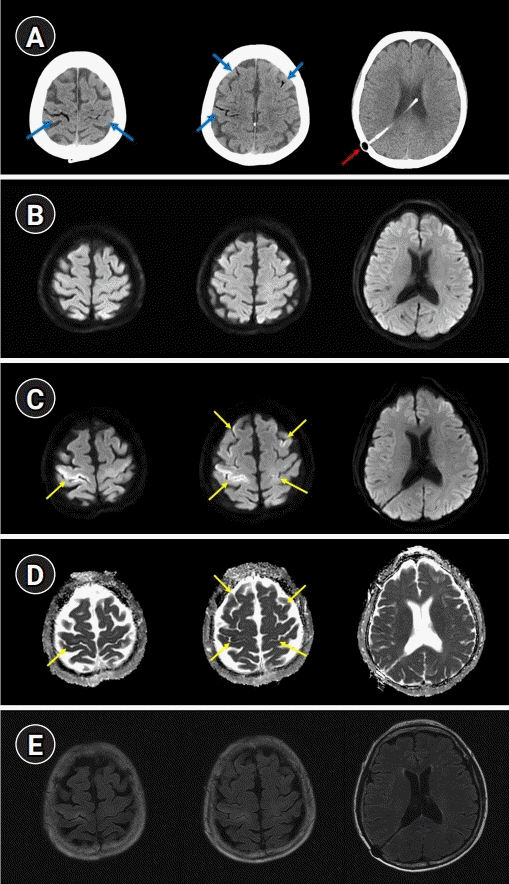A 63-year-old woman had a sudden cardiac arrest while undergoing tooth scaling. After 4 minutes, the return of spontaneous circulation (ROSC) was achieved. She was stuporose, but other neurological examinations were within normal limits. The patient had a history of meningitis, and she had undergone ventriculoperitoneal shunt surgery for hydrocephalus in her 20s. Brain computed tomography performed immediately after ROSC showed cerebral air emboli (Fig. 1A). Brain magnetic resonance imaging (MRI) after 5 hours showed no acute lesions (Fig. 1B). Targeted temperature management was performed. Her consciousness improved to a drowsy state, but left hemiparesis was observed. Brain MRI performed on the 6th day showed gyriform infarction in both frontoparietal cortices that were consistent with air emboli (Fig. 1C-E).
Cerebral air embolism can lead to arterial and venous infarctions [1,2]. They can lead to blood flow obstruction and induce an inflammatory reaction with the breakdown of the blood-brain barrier [3]. In this case, the delayed cerebral infarction was detected by follow-up brain imaging. Cerebral venous air emboli can cause delayed cerebral infarction because the collateral circulation in the cerebral venous system allows for compensation. Even if the initial MRI is negative, repeated brain MRI may help detect cerebral infarctions caused by cerebral venous air emboli.
Notes
Ethics statement
This case was reviewed and approved by the Institutional Review Board of Dong-A University Hospital (IRB No. DAUHIRB-21-105). Informed consent was waived by the Board.
Conflict of interest
Dr. Jeong JH is an editorial board member of the journal but was not involved in the peer reviewer selection, evaluation, or decision process of this article. No other potential conflicts of interest relevant to this article were reported.
Fig. 1.
Brain computed tomography and magnetic resonance imaging (MRI). (A) Non-contrast computed tomography of the head performed immediately after the return of spontaneous circulation (ROSC) showing air bubbles in the frontoparietal sulci (blue arrow). A ventriculoperitoneal shunt catheter was inserted in the right lateral ventricle (red arrow). (B) Diffusion-weighted brain MRI 5 hours after ROSC showing no acute lesions. (C-E) A follow-up brain MRI was performed on the 6th day after ROSC. Diffusion-weighted images and apparent diffusion coefficient images showed focal gyriform infarction in both frontoparietal cortices, especially in the right motor cortex (yellow arrows). Fluid-attenuated inversion recovery images showed high signal intensities in the same area.





 PDF
PDF Citation
Citation Print
Print



 XML Download
XML Download